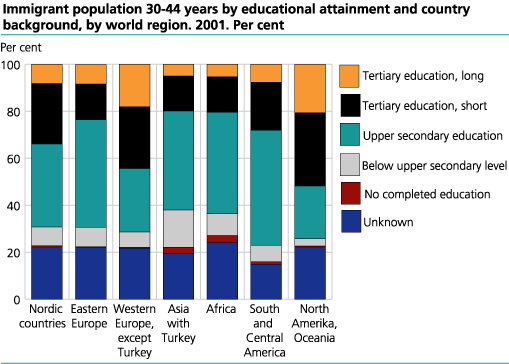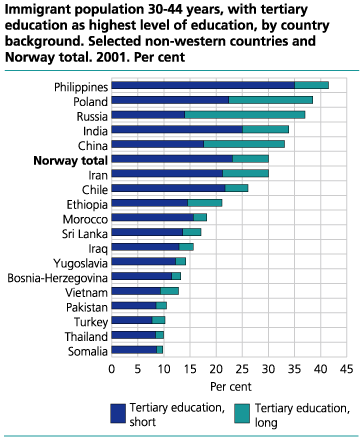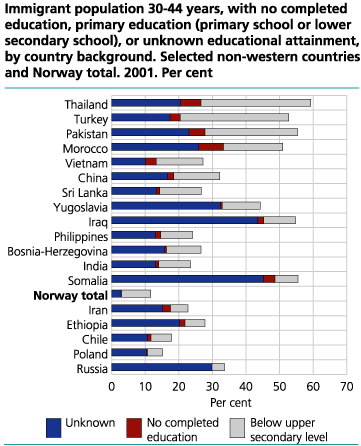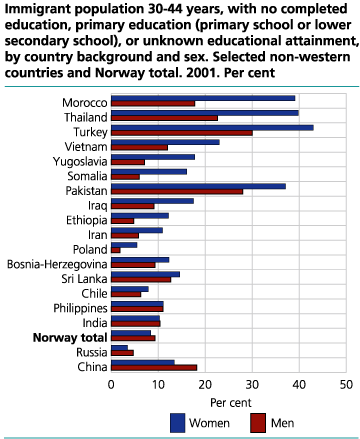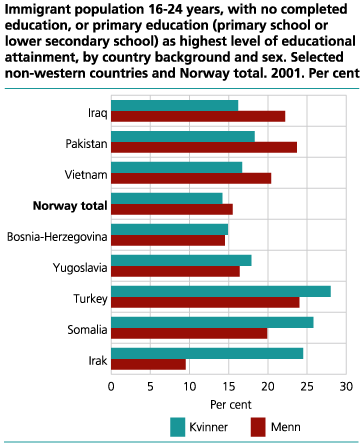Content
Published:
Many non-western immigrants more educated than non-immigrants
The portion of highly educated is larger among immigrants from the Philippines, Poland, Russia and India than among the total population in Norway. Immigrants from Somalia, Pakistan and Thailand are worst off when it comes to educational attainment, and many women from non-western countries have little education or no schooling at all.
Considering immigrants' educational attainment according to world region, immigrants from Asia and Africa have the lowest levels at average. Educational attainment varies much according to country background. Immigrants aged 30-44 years from the Philippines, Poland, Russia, India, China and Iran, have at average a higher level of educational attainment than the average among all people in Norway in the same age group. 42 per cent of the immigrants from the Philippines have completed tertiary education. Among non-immigrants the portion is 30 per cent. 23 per cent of the Russian immigrants have completed long tertiary education, i.e. a length of at least 4 ½ years. This is more than three times as much as for people outside the immigrant population, where the portion with long tertiary education is 7 per cent. Immigrants from Turkey, Somalia, Pakistan and Thailand are worst off when it comes to educational attainment: The portion with highest level of education at tertiary level, short or long, is around 10 per cent, but there are many immigrants on which we do not have any educational information 1 .
A third of all Thais, Turks and Pakistanis have only completed primary education
When looking at immigrants aged 30-44 years there are many with no education beyond lower secondary school among immigrants from Thailand, 40 per cent, Turkey, 36, and Pakistan 32 per cent. More than one out of three has completed only ten years of schooling or less. Among immigrants from Russia, Poland, Chile, Ethiopia and Iran there are very few with no completed education, or only basic education, 4-8 per cent. This is a smaller portion than among non-immigrants. Immigrants from Chile have a pattern of educational attainment very similar to the country average in Norway.
Many non-western women not part of the education race
Among non-immigrants there are more women than men with a high level of educational attainment. And while women from western countries at average have a higher level of education than men, there is an opposite tendency among immigrants from non-western countries. The largest differences in educational attainment between the sexes are found among immigrants from Asia and Africa. There are also large differences among women from different non-western countries. This is particular evident when it comes to women from Thailand and the Philippines. The portion of women among immigrants from these countries is 94 and 86 per cent respectively. 42 per cent of the women from the Philippines have tertiary education, but only 9.5 percent of the women from Thailand. Many of the women from the Philippines are nurses.
Young immigrants continue on to upper secondary education
When comparing level of educational attainment among different groups it is important to be aware of the fact that the persons born in Norway with two foreign-born parents are much younger than other groups. More than 60 per cent are below 10 years, and only 4 per cent are more than 30 years of age. Still, the portion that has completed primary and secondary education (16-24 years) is close to the level among non-immigrants 16-24 years: 89 and 91 per cent. Participation in secondary education among 16-18 year olds in this immigrant group is about the same level as for all 16-18 year olds ( http://www.ssb.no/emner/02/sa_innvand/sa50/kap3.pdf) . Participation in tertiary education is also higher among immigrants' children than among first generation immigrants.
1 Unfortunately there are many immigrants we do not have educational information about. This concerns in particular immigrants with a relatively short period of residence in Norway. For more information on data sources read "About the statistics".
Tables:
- Table 1 Persons 30-44 years, by level of education, gender, immigrant category and country background. 2001. Percentages
- Table 2 Persons 16-24 years, by level of education, gender, immigrant category and country background. 2001. Percentages
- Table 3 Persons 16 years and above, by level of education, gender, immigrant category and country background. 2001. Percentages
The statistics is now published as Educational attainment of the population.
Contact
-
Statistics Norway's Information Centre
E-mail: informasjon@ssb.no
tel.: (+47) 21 09 46 42

